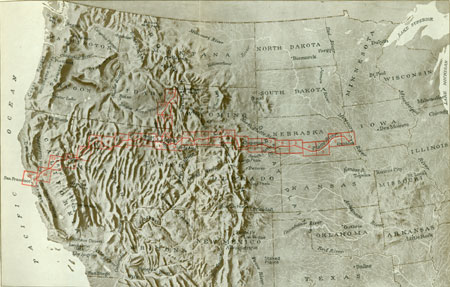
|
Geological Survey Bulletin 612
Guidebook of the Western United States: Part B |
GUIDEBOOK OF THE WESTERN UNITED STATES.
PART B. THE OVERLAND ROUTE, WITH A SIDE TRIP TO YELLOWSTONE.
By WILLIS T. LEE, RALPH W. STONE, HOYT S. GALE, and others.
INTRODUCTION
The westbound traveler over the Union Pacific Railroad will view in the course of his journey some of the most conspicuous geographic features of the North American Continent. These are shown in the accompanying illustration (Pl. I). The east end of the route lies in the broad, well-watered Mississippi Valley, where an abundance of rainfall is indicated by the numerous branching streams. On leaving Omaha the traveler crosses the Great Plains, which rise gradually to the west and become progressively drier, merging into the relatively barren region formerly called the Great American Desert. This change in character is not very apparent to the traveler, because the railroad follows a valley whose bottom lands in the arid part of the Great Plains are irrigated and do not differ in general appearance from those farther east, where the rainfall supplies sufficient moisture for growing crops. On both sides of this valley in western Nebraska the land is utilized for grazing and for dry farming. The cultivation of the Great Plains by dry farming is rapidly spreading as new methods become more widely understood, and the region can no longer be called a desert. In eastern Wyoming the route is in a belt of grazing country.
West of the Great Plains lies a general mountainous country, known as the Cordilleran region, which extends westward to the Pacific coast. At Granite Canyon, Wyo., the railroad reaches the eastern margin of the Cordilleran region, marked by a spur of the southern Rocky Mountains—the Laramie Range—and thence westward it winds around detached mountain groups and through the intervening basins. The traveler may not realize that he is in a mountainous region, for most of the lofty mountains of southern Wyoming stand at considerable distances from the railroad. The mountainous part of the route is not well populated. Many of the stations are little more than section houses, and some consist only of a post on which is painted the name, to indicate the location of a sidetrack. This part of Wyoming is used mainly for stock raising, but in the irrigated valleys farther west, in Utah, there are orchards and well-tilled fields.
Soon after entering Utah the traveler crosses the Wasatch Mountains, one of the great ranges of the continent, through the canyon cut by Weber River, and then enters the valley of Great Salt Lake.
Leaving Ogden on the westward journey the traveler is fairly within the Great Basin, one of the major natural divisions or physiographic provinces of the United States, and he will be passing through it for more than 16 hours. The Great Basin is called a desert and as a whole gives an impression of dreariness and desolation, but it has a peculiar interest not possessed by any other part of the transcontinental route. It is one of the most productive mining regions of the world. That it is not all a desert is shown by the fact that large numbers of cattle and sheep are raised within its limits. It is developing, moreover, to an increasing extent in agriculture.
Beyond the Great Basin lies the Sierra Nevada, which on this route marks approximately the boundary between Nevada and California. Through the forest zone of the Sierra the traveler descends into the Great Valley of California and, crossing its broad plains, passes, by way of the one tidal outlet through the Coast Ranges, to the metropolis of the Pacific coast.
NOTE.—For the convenience of the traveler the sheets of the route map in this bulletin are so arranged that he can unfold them one by one and keep each one in view while he is reading the text relating to it. A reference is made in the text to each map at the place where it should be so unfolded. The areas covered by these sheets are indicated on Plate I, and a list of the sheets and the other illustrations is given on pages 237-240. A glossary of geologic terms is given on pages 232-236, and an index of stations on pages 241-244.
| <<< Previous | <<< Contents >>> | Next >>> |
bul/612/intro.htm
Last Updated: 28-Mar-2006
